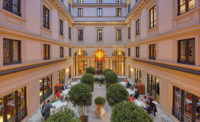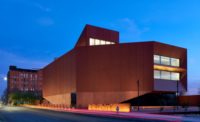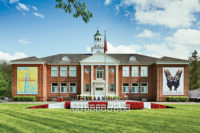Mexico City
Amid the traffic and bustle of central Mexico City, the fortresslike Ciudadela building sprawls territorially across its 7-acre parcel of land, bordered by the busy Balderas Avenue and bright yellow vendor carts to the east, a smaller street to the west, and public plazas to the north and south. Tucked within its stone confines, along the building's northwest perimeter and facing an interior courtyard, is the diminutive Antonio Castro Leal library, a newly renovated space designed by Mexico City–based BGP Arquitectura to house the private collection of the Mexican intellectual, diplomat, and National University president who died in 1981.
A single-story structure built on a square plan, La Ciudadela has a history that is as rich as its walls are thick. Commissioned by the Spanish crown at the end of the 18th century, the building, which rests on a robust vaulted foundation over swampland, started its life as a tobacco-processing facility—the four large courtyards at its center were used for drying leaves. Through the 19th century the building served as a military post, an arsenal, and a hospice for the poor. It earned its name La Ciudadela (The Citadel) in 1885, when it became the northern barracks of the city garrison. Later it was used for weapons manufacturing, and then, in the 1940s, part of the building was turned over to the nation's general archive and another part to the National Library. In the 1960s other cultural and educational institutions moved in to share the space. More recently, in 1987, Mexican architect Abraham Zabludovsky enclosed the main courtyards with enormous steel canopies to create reading rooms and file storage.
In 2010, with the building having fallen into disrepair, and with the end of President Felipe Calderón's term drawing nearer, Consuelo Sáizar, director of the National Council for Culture and Arts, called in architects Bernardo Gómez-Pimienta of BGP and Alejandro Sánchez to create a master plan for adapting and restoring the 325,000-square-foot Ciudadela as a center of culture and study for the National Library. Accordingly, the two recommended a number of Mexican architects (including Tatiana Bilbao and Mauricio Rocha) to design various spaces within it—libraries, offices, galleries—while overseeing some of the interiors themselves. The Castro Leal library is one of the first finished pieces of the larger undertaking, which today is deep in the throes of renovation, racing toward a November completion date, when the president will inaugurate the building.
Gómez-Pimienta took on the conversion of two 72-by-23-foot perimeter bays to house the 50,000 titles that make up Castro Leal's personal library. The eclectic collection, organized by country as its late owner intended, is one of five holdings of people in culture that the National Library has recently purchased. The challenge was to leave the original walls of the 5,685-square-foot space untouched, as mandated by the historical and landmark-preservation agencies. So Gómez-Pimienta anchored I-beams vertically at 10-foot intervals in the floor and ceiling, separating them from the 3-foot-thick stone walls with a 4-inch gap. The structure supports the shelves, made of walnut to honor the dark wood shelving in Castro Leal's house in the borough of Coyoacán. Perimeter balconies and stairs composed of three layers of tempered, sandblasted glass also hang from the I-beams, as well as from the ceiling, and provide a visual break from the relentless rows of books lining the walls from floor to ceiling, as they did in Castro Leal's home. Local code allowed for railings just ¾-inch thick with horizontal bars spaced only every foot, enabling the walkways to float gracefully. “I used the slimmest elements possible,” says the architect, “so you can get this sense of lightness.”
To underscore the contrast between the staunch old structure and the new light architecture of glass and steel, Gómez-Pimienta used white-stained oak on the floors and made the furniture (much of which he designed) white. “I wanted to be very neutral,” he says. “The important part is the books, so I worked with a reduced palette of materials.” Light monitors set into the vaulted ceiling illuminate the two rooms during the day. And LEDs installed in coves within the stacks bring the patchwork of colors and textures of the book spines to the fore.
Gómez-Pimienta's instinct to use a light hand in this delicate intervention and let the books take center stage has resulted in an elegant space that is apt for the elevated pursuit of scholarship. These choices also portend well for the larger project that is unfolding as the next chapter for Mexico City's venerable Ciudadela.
Cost: $1.39 million
Completion Date: December 2011
Gross Square Footage:
5,685 sq-ft
People
Owner:
Architect and Designer:
Personnel in architect's firm who should receive special credit: Interior designer: BGP Arquitectura
Engineer(s): Structural: Izquierdo Ingenieros Asociados, S.C.
Consultant(s): Other: Graphic Design and Museography: Varela + Kimura, Artist: Alejandra Zermeño General contractor: CAV Diseño e Ingeniería, S. A. de C. V.
Photographer(s): Renderer(s): Erik Barrón. CAD system, project management, or other software used: Autocad |
Products
Structural system
Windows
Doors
Furnishings Reception furniture: custom by BGP Arquitectura Chairs: Eames chairs by Vitra Other furniture: armchairs and low tables by BGP Arquitectura
Lighting |



















Post a comment to this article
Report Abusive Comment